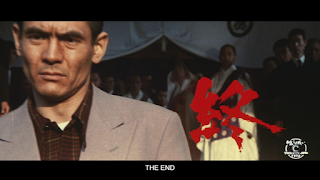Director: Kinji Fukasaku, Starring: Bunta Sugawara, Hiroki Matsukata, and Nobuo Kaneko
Most
of you reading this are probably familiar with at the name Battles Without Honor and Humanity/Jingi Naki Tatakai or The Yakuza Papers. This operatic series
chronicles the decades following World War II in Hiroshima city. When I say
decades, I mean actual decades. Each film covers a set of years in the life of
various crime families. The first film centers on the Yamamori and the Doi.
Their conflicts, team ups, and trials of co-existing in the same city.
Legendary
director, Kinji Fukasaku (Battle Royale,
2000), helmed the series. Prior to his iconic and heavily influential series,
he tackled a variety of genres mainly focusing on crime and action films. Early on Yakuza played a significant role in
his fiction. During the 1960s, Nikkatsu dominated the cheap action genre. They
developed and cranked out dozens of Yakuza-eiga, mainly Ninkyo-eiga. These were
Yakuza films where the gangsters are Robin Hood-esque figures who are honorable
knights who fight the corruption. This subgenre died in the box office. The
Jitsuroku-eiga films tookover. They were the mirror image of Ninkyos. They were
not lovably flawed heroes. They were selfish men who want to succeed in the
emerging economic powerhouse that was Japan.
Battles
begins in 1946 with an attempted rape in a densely crowded open market. Several
white men strip her as local gangsters and an ex-soldier, Shozo, defend her.
The police side with the Americans to no avail. Young gangsters clash with the Doi-gumi
(Doi Family), who left a young thug maimed. Shozo kills that Doi man for his new friends. In
prison, he becomes blood brothers with Wakasugi of the Doi clan. Wakasugi secures a way out for Shozo, Oyabun (boss) Yamamori. He bails out Shozo and
recruits him to his new Yakuza family. Things start good until a Doi man causes
a ruckus at a gambling den. That Doi man has a powerful uncle, underground
elder Okubo. He
wants a city vote rigged. The vote gets rigged but the Yamamori clan's
tolerant relationship with the Doi is over. Word gets out that the Yamamori clan got 50
million from said deal. Shozo is sent to kill Oyabun Doi. After the deed is
done, Yamamori sells him out. With nowhere to go he turns himself in.
Wakasugi gets revenge but is killed later that night. Again Boss Yamamori bails Shozo. He wants Shozo to kill Sakai Tetsuya, a Yamamori captain.
Sakai broke away to form a new family with the remains of the Doi family. Shozo can’t kill Sakai, who
continues to kill off Yamamori rivals. While getting a toy for his kid, Yamamori men gun him dead. At the funeral, Shozo shoots up the funeral display with the
symbols of every prominent Hiroshima Yakuza. He walks away.

To
put it lightly, the plot is dense. There are dozens of named characters that
each play a specific role withing the drama of the clashing clans. I only named
the primary players - Shozo, Oyabun Yamamori, Sakai Tetsuya, and Wakasugi
Hiroshi. These 4 are the core of the film. Each of them are embodiments of a
theme. Shozo is innocence. Oyabun Yamamori is corruption. Sakai Tetsuya is
opportunity. Wakasugi Hiroshi is the harsh reality. Earlier I mentioned that
this was a jitsuroku-eiga. Shozo has the aspects of an honorable criminal like
in a ninkyo-eiga. Aside from that, he carries himself like an old-fashioned guy. This includes his taste in music, chivalric code, and his realization of what Yakuza life is actually. This separates him from the rest of the Yamamori. The divide is immediate and only grows as the story evolves. As the film goes on he realizes that his Oyabun can be wrong
and extremely manipulative. The world of the Yakuza-gumi as Shozo understands
is destroyed. Shozo is merely a tool.
The glitz and glimmer of Yakuza life isn’t shiny
and beautiful. People are corrupt. People are opportunists willing to do
anything to for power, not just money. Sakai saw Shozo’s 2nd prison sentence as
the chance to kill off the remaining competition before shacking up with
Wakasugi’s widow (and having a kid with her). Not just that but he dresses like
an American gangster with the pinstripe suit.
In
line with the harsh reality of a criminal’s life, violence is treated very
seriously. It’s quick, brutal, and ugly. The camera follows every violent act
like a fly on the wall. You see every drop of blood, every drip of sweat, and
every bullet bursting someone’s flesh. The violence is spread apart very
smartly. The tension builds then someone we know gets horrifically killed. It
isn’t fun. It isn’t pleasant. These are the most intimate scenes. We feel their anger. We know the exact reason behind that
anger. The only result of violence is regret. The survivors are
never happy with the results.
It's a cliche to say that the camera is a character in most cases. That isn't true here. Everything on-screen is presented without any smoke or mirrors. Whether scenes take place in massive overly crowded areas or a small closed room. The claustrophobia is palpable. You want to leave but you can't. The tension can't be cut with a knife. You'd need a brand new katana by Hanzo. We see the depravity of every character in graphic detail. No one, even Shozo, comes out looking respectable.
Battles is not for everyone. It's bleak with a bleak sense of black humor. It's graphic, dense, and violent. The series doesn't lighten up from here. Personally, I love it.
Battles Without Honor and Humanity is on DVD, Blu-Ray, and various streaming services.






Comments
Post a Comment